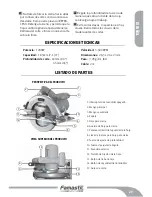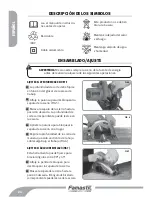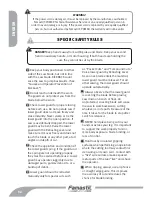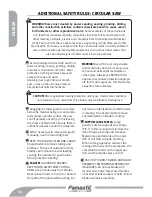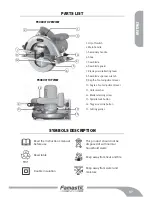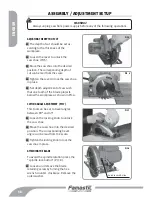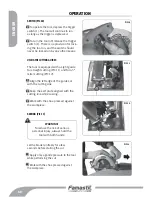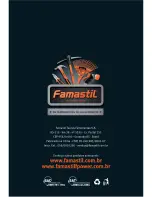
34
ENGL
IS
H
ADDITIONAL SAFETY RULES: CIRCULAR SAW
Avoid prolonged contact with dust from
power sanding, sawing, grinding, drilling,
and other construction activities. Wear
protective clothing and wash exposed
areas with soap and water.
Allowing dust to get into your mouth,
eyes, or lay on the skin may promote
absorption of harmful chemicals.
WARNING!
Some dust created by power sanding, sawing, grinding, drilling,
and other construction activities contains chemicals known to cause cancer,
birth defects or other reproductive harm.
Some examples of these chemicals
are: lead from lead-based paints, crystalline silica from bricks and cement and
other masonry products, arsenic and chromium from chemically-treated lumber
(CCA). Your risk from these exposures varies, depending on how often you do this
type of work. To reduce your exposure to these chemicals: work in a well ventilated
area, and work with approved safety equipment, such as those dust masks that
are specially designed to filter out microscopic particles.
CAUTION!
Wear appropriate hearing protection during use. Under some conditions
and duration of use, noise from this product may contribute to hearing loss.
WARNING!
Use of this tool can generate
and/or disburse dust, which may cause
serious and permanent respiratory or
other injury. Always use NIOSH/OSHA
approved respiratory protection appropri-
ate for the dust exposure. Direct particles
away from face and body.
Snagging the lower guard on a surface
below the material being cut can momen-
tarily reduce operator control. The saw
can lift partially out of the cut increasing
the chance of blade twist. Ensure there is
sufficient clearance under the workpiece.
When necessary to raise lower guard
manually, use the retracting lever.
KEEP THE BLADES CLEAN AND SHARP.
Sharp blades minimize stalling and
kickback. The use of dull and/or dirty
blades can increase the saw loading
causing the operator to push harder
which promotes twisting..
DANGER!
LACERATION HAZARD.
KEEP HANDS AWAY FROM CUTTING
AREA. Keep hands away from blades.
Never place hands in front of or behind
the path of the blade while cutting. Do
03
02
01
04
05
06
07
not reach underneath work while blade
is rotating. Do not attempt to remove
cut material when blade is moving.
SUPPORT LARGE PANELS.
Large
panels must be supported as shown
(PIC 1) in this manual to minimize the
risk of blade pinching and kickback.
Material supported only at the ends
(PIC 2) will lead to blade pinching.
When cutting operation requires the
resting of the saw on the workpiece, the
saw shall be rested on the larger por-
tion and the smaller piece cut off.
USE ONLY CORRECT BLADES AND BLADE
ASSEMBLY COMPONENTS WHEN MOUNT-
ING BLADES. Do not use blades with
incorrect size holes. Never use defective
or incorrect blade washers or bolts. Follow
blade assembly procedures.




